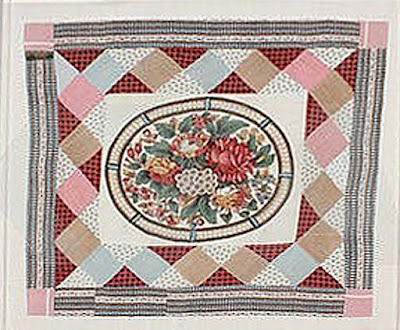Panel #39 in an appliqued bedcover dated 1812 with initials E.I.,
Gawthorpe Hall Textiles Collection,
Lancashire, England
One of the earliest date-inscribed uses of multicolor chintz panels
in a quilt made in Great Britain.
The quilt is 98” x 111" and includes two panels.
The panel is octagonal, a bouquet of flowers tied with a blue ribbon and framed in a triple border of diamonds and leaves with blue lozenge shapes in the angles.
The border might have been drawn from a Georgian silver platter.
It's a pretty design, wood-block printed in full chintz style. Were the browns always brown? Hard to say. Could have been purple.
We have five quilts with the panel, all British frame quilts with a central focus and a sixth one that is probably British.
Collection of Cindy Vermilion Hamilton
Probably British
Cindy's bedcover features panel #1 in the center, bordered with birds and then half and
quarters of Panel #39
The blue bowknot at the bottom of the bouquet is a visual clue that the center panel
in this quilt in the collection of the Victoria & Albert Museum is #39.
Little is known about this bedcover.
Four of the octagonal panels rotate around the center bird panel in
this piece auctioned by Kerry Taylor in London.
The long-necked bird panel (# 11) is usually seen in American quilts, but this quilt
by style and location is obviously British.
Below: Panel 39 rotates around a center focus panel (# ) at the top half of this medallion. The quilt was documented in the Prince Edward Island project and featured in their book by Sherrie Davidson. The story passed on with it is that it was stitched for an 1810 wedding that never took place.
Prince Edward Island is in Canada, north of Maine and Nova Scotia---British America.
The family date is consistent with the date on the quilt at the top of the page here.
Another British Empire quilt with Panel #39
Spread attributed to Mary Moxey of Williamtown, New South Wales,
Australia. National Trust (NSW) Collection
The cross-stitch inscription on the left:
"Mary Moxey. 1818"
On the right:
"Emma Tremlett Born Decr 16th 1837"
Did Mary Moxey make this piece in 1818 in England and dedicate it to young Emma years later in Australia?
The frame is related to the Wellington/Vittoria panel celebrating the Duke of Wellington's 1813 British victory in Spain during the Napoleonic Wars. Note the dark center on the Wellington panel.
We don't often see the dark-centered designs used in American quilts. And this victory panel would have been quite unpopular with Americans in 1813 who were at war with the British.
What Can We Learn From Panel #39?
Center of a hexagon quilt in the collection of the International
Quilt Study Center and Museum #1997-007-0341 with Panel #22
As we continue to sort out the panels and the quilts we see a difference in taste in the U.S. and the U.K. Americans tended to use the white ground panels. Britons also used the white panels but we have found more dark ground designs in Great Britain.
Source?
It's not a fool-proof clue to location, but when we see a dark
ground panel we guess the quilt is from Great Britain.
Kerry Taylor auction in England, 2012
Another regional clue is the panel's frame style. Like Panel #39 panel #38 in the crib quilt above is framed with what looks like the edge of a silver platter. Circular beads imitate embossed metal work---an elegant look.
The blue ovals might be jewels.
We only have two quilts with the oval Panel #38.
The other piece with Panel #38 is attributed to Marianna Lloyd Button,
thought to have been made in England and brought to Tasmania
in 1833...
...shown in Making the Australian Quilt
Here's a panel with both style characteristics---dark ground and embossed frame style---
in a British bedcover in the collection of the International
Quilt Study Center and Museum.
IQSC #2007-014-0001 is thought to have been made in Allendale, England.
More examples of colored-ground panels and the platter-like frames later.
UPDATE:
My calendar from the Metropolitan Museum shows this French Sevres Drop Front Desk from the 18th century. Certainly gives us insight as to where blue ribbons and roses come from.




























I know I am stating the obvious, but there are several leaf and lozenge borders on these medallions. Perhaps copied by other manufacturers? At one point, I thought they might be a series or set of medallions. I decided they weren't exact enough copies for that to be. Any other ideas appreciated.
ReplyDeleteThis is the best panel among all of your digitizing panels. love it.
ReplyDeleteThis is the lovely blog and great post.
ReplyDeleteThanks for sharing
Win Digitizing